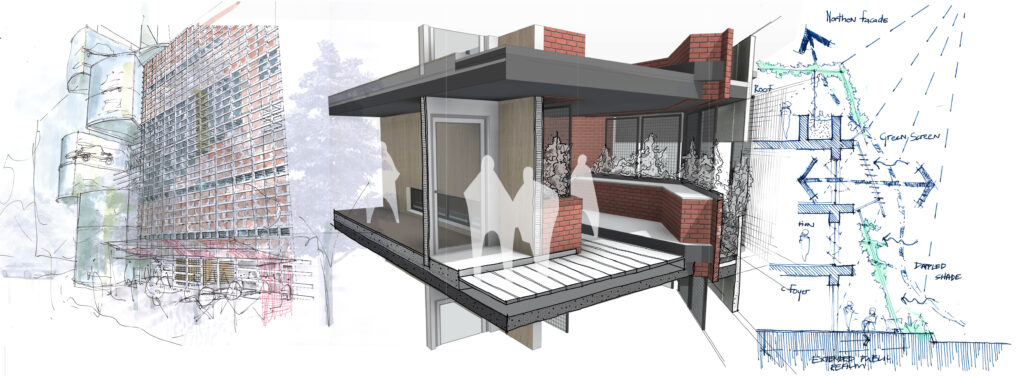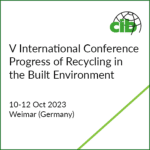CIB announces new research project into smart flexible façade as one of the winners of the Vistas award, to be undertaken at the University of Pretoria.
Climate change action requires local responses that are supported by global knowledge. A research project aimed at developing a testing facility to advance smart and flexible façade strategies for climate change resilience in multi-story buildings in Southern Africa has been announced as a recipient of he CIB Vistas programme to develop its pilot phase.

The latest IPCC assessment report highlights Africa as one of the most vulnerable regions to climate change-related impacts (IPCC 2022). As one of the fastest urbanising continents with a growing, young population, it is critical to develop sustainable African cities that promote our wellbeing (SDG11) and built environments that mitigate and adapt to climate change impacts (SDG13). In this pursuit, the built environment plays a pivotal role by reducing urban dwellers’ exposure to adverse impacts, improving their adaptive capacity, and promoting resource-efficient construction.
Although extensive work has been undertaken to address specific climate change risks and mitigation measures, more research is still needed into the leverage potential and compatibility of diverse strategies as integrated multifunctional solutions. This is specifically of concern as context-specific meteorological, spatial, and material conditions play significant roles in the efficiency and success of integrated reciprocal climate change response strategies. This requires not only the integration of multiple climate change adaptation strategies but also collaboration between diverse built environment specialists. A critical factor is the building users and their ability to adjust and optimize spaces to a given risk (Sonetti et al. 2018; Hugo 2021). To effectively investigate this, real-life and digital simulation scenarios must be developed and monitored to consider the user, built environment interfaces, and the integration of diverse response strategies.
The project proposes the construction of a testing facility to develop and test smart and flexible façade strategies that can improve climate change resilience on a building scale. This will include monitoring changes and adjustments in the built environment. Concurrently, a digital model will be developed to replicate this experiment to ultimately improve our digital simulation capabilities in sub-tropical climatic conditions and understand the effect of a changing climate and users on the built environment.
The CIB Vistas Programme supports this project by initiating a pilot study for the larger project and aims to undertake a knowledge exchange with research partners at Delft University of Technology in the Netherlands and Chalmers University of Technology in Sweden. Given the significant cost associated with the development of physical testing facilities, the team are undertaking a precedent analysis of existing living labs and testing facilities at these two leading universities – the Green village at TUDelft and HSB facility at Chalmers.
While we envision this as a much larger research project with multiple project partners, there are critical team members involved in this pilot phase. Our research team from the University of Pretoria includes Prof Chrisna du Plessis, Dr Jan Hugo and Paul Sonnendecker. Additionally, our research partners from collaborating universities are Prof Andy van den Dobbelsteen from Delft University of Technology, and Prof Holger Wallbaum and Dr Elena Malakhatka from Chalmers University of Technology.

University of Pretoria

University of Pretoria

University of Pretoria

Delft University of Technology

Chalmers University of Technology

Chalmers University of Technology
From this engagement, they hope to learn from existing precedents and promote inter-institutional collaboration. While the project and its application will ultimately respond to local Southern African meteorological conditions, they believe the research findings can support other regions that will be shifting towards dryer temperate climates as climate change progresses. Finally, they hope to stimulate local talent and skills to develop Southern African youth as active partners in local climate change action plans.
References
Hugo, J.M. 2021. The Hanoak House as a Flexible and Adaptable Vernacular Precedent for Modern Architecture. International Journal of Sustainable Development and Planning. 16(4):731–739.
IPCC. 2022. Climate Change 2022. Impacts, Adaptation and Vulnerability in: Working group II contribution to the Sixth Assessment Report on the Intergovernmental Panel on Climate Change. Cambridge: Cambridge University Press.
Sonetti, G., Naboni, E. & Brown, M. 2018. Exploring the Potentials of ICT Tools for Human-Centric Regenerative Design. Sustainability. 10(1217):1–14. DOI: 10.3390/su10041217.



